Acquisition of regulators of complement activation by Streptococcus pyogenes serotype M1
- PMID: 12379699
- PMCID: PMC130388
- DOI: 10.1128/IAI.70.11.6206-6214.2002
Acquisition of regulators of complement activation by Streptococcus pyogenes serotype M1
Abstract
Opsonization of bacteria by complement proteins is an important component of the immune response. The pathogenic bacterium Streptococcus pyogenes has evolved multiple mechanisms for the evasion of complement-mediated opsonization. One mechanism involves the binding of human regulators of complement activation such as factor H (FH) and FH-like protein 1 (FHL-1). Acquisition of these regulatory proteins can limit deposition of the opsonin C3b on bacteria, thus decreasing the pathogen's susceptibility to phagocytosis. Binding of complement regulatory proteins by S. pyogenes has previously been attributed to the streptococcal M and M-like proteins. Here, we report that the S. pyogenes cell surface protein Fba can mediate binding of FH and FHL-1. We constructed mutant derivatives of S. pyogenes that lack Fba, M1 protein, or both proteins and assayed the strains for FH binding, susceptibility to phagocytosis, and C3 deposition. Fba expression was found to be sufficient for binding of purified FH as well as for binding of FH and FHL-1 from human plasma. Plasma adsorption experiments also revealed that M1(+) Fba(+) streptococci preferentially bind FHL-1, whereas M1(-) Fba(+) streptococci have similar affinities for FH and FHL-1. Fba was found to contribute to the survival of streptococci incubated with human blood and to inhibit C3 deposition on bacterial cells. Streptococci harvested from log-phase cultures readily bound FH, but binding was greatly reduced for bacteria obtained from stationary-phase cultures. Bacteria cultured in the presence of the protease inhibitor E64 maintained FH binding activity in stationary phase, suggesting that Fba is removed from the cell surface via proteolysis. Western analyses confirmed that E64 stabilizes cell surface expression of Fba. These data indicate that Fba is an antiopsonic, antiphagocytic protein that may be regulated by cell surface proteolysis.
Figures
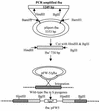
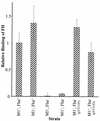
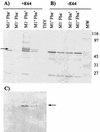
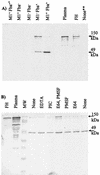
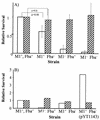
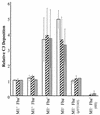
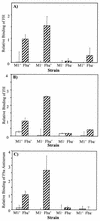
Similar articles
-
Impact of the SpeB protease on binding of the complement regulatory proteins factor H and factor H-like protein 1 by Streptococcus pyogenes.Infect Immun. 2005 Apr;73(4):2040-50. doi: 10.1128/IAI.73.4.2040-2050.2005. Infect Immun. 2005. PMID: 15784545 Free PMC article.
-
Recruitment of complement factor H-like protein 1 promotes intracellular invasion by group A streptococci.Infect Immun. 2003 Dec;71(12):7119-28. doi: 10.1128/IAI.71.12.7119-7128.2003. Infect Immun. 2003. PMID: 14638802 Free PMC article.
-
Group A streptococcal phagocytosis resistance is independent of complement factor H and factor H-like protein 1 binding.Mol Microbiol. 2001 Aug;41(4):817-26. doi: 10.1046/j.1365-2958.2001.02496.x. Mol Microbiol. 2001. PMID: 11532146
-
Binding of complement regulatory proteins to group A Streptococcus.Vaccine. 2008 Dec 30;26 Suppl 8:I75-8. doi: 10.1016/j.vaccine.2008.11.054. Vaccine. 2008. PMID: 19388169 Review.
-
Molecular aspects of the phagocytosis resistance of group A streptococci.Eur J Epidemiol. 1988 Sep;4(3):289-300. doi: 10.1007/BF00148912. Eur J Epidemiol. 1988. PMID: 3053236 Review. No abstract available.
Cited by
-
Demonstration of factor H-like protein 1 binding to Treponema denticola, a pathogen associated with periodontal disease in humans.Infect Immun. 2005 Nov;73(11):7126-32. doi: 10.1128/IAI.73.11.7126-7132.2005. Infect Immun. 2005. PMID: 16239506 Free PMC article.
-
Targeted quantitative analysis of Streptococcus pyogenes virulence factors by multiple reaction monitoring.Mol Cell Proteomics. 2008 Aug;7(8):1489-500. doi: 10.1074/mcp.M800032-MCP200. Epub 2008 Apr 13. Mol Cell Proteomics. 2008. PMID: 18408245 Free PMC article.
-
Disruption of the alternative pathway convertase occurs at the staphylococcal surface via the acquisition of factor H by Staphylococcus aureus.Mol Immunol. 2011 Jan;48(4):683-90. doi: 10.1016/j.molimm.2010.11.014. Epub 2010 Dec 15. Mol Immunol. 2011. PMID: 21163532 Free PMC article.
-
Surface proteins of Streptococcus agalactiae and related proteins in other bacterial pathogens.Clin Microbiol Rev. 2005 Jan;18(1):102-27. doi: 10.1128/CMR.18.1.102-127.2005. Clin Microbiol Rev. 2005. PMID: 15653821 Free PMC article. Review.
-
The potential of bacterial anti-phagocytic proteins in suppressing the clearance of extracellular vesicles mediated by host phagocytosis.Front Immunol. 2024 Jun 6;15:1418061. doi: 10.3389/fimmu.2024.1418061. eCollection 2024. Front Immunol. 2024. PMID: 38903499 Free PMC article. Review.
References
-
- Berge, A., and L. Bjorck. 1995. Streptococcal cysteine proteinase releases biologically active fragments of streptococcal surface proteins. J. Biol. Chem. 270:9862-9867. - PubMed
-
- Berge, A., B. M. Kihlberg, A. G. Sjoholm, and L. Bjorck. 1997. Streptococcal protein H forms soluble complement-activating complexes with IgG, but inhibits complement activation by IgG-coated targets. J. Biol. Chem. 272:20774-20781. - PubMed
-
- Caparon, M. G., and J. R. Scott. 1991. Genetic manipulation of pathogenic streptococci. Methods Enzymol. 204:556-586. - PubMed
Publication types
MeSH terms
Substances
Grants and funding
LinkOut - more resources
Full Text Sources
Research Materials
Miscellaneous

